check engine HONDA PASSPORT 2002 2.G Owner's Manual
[x] Cancel search | Manufacturer: HONDA, Model Year: 2002, Model line: PASSPORT, Model: HONDA PASSPORT 2002 2.GPages: 294, PDF Size: 3.97 MB
Page 181 of 294
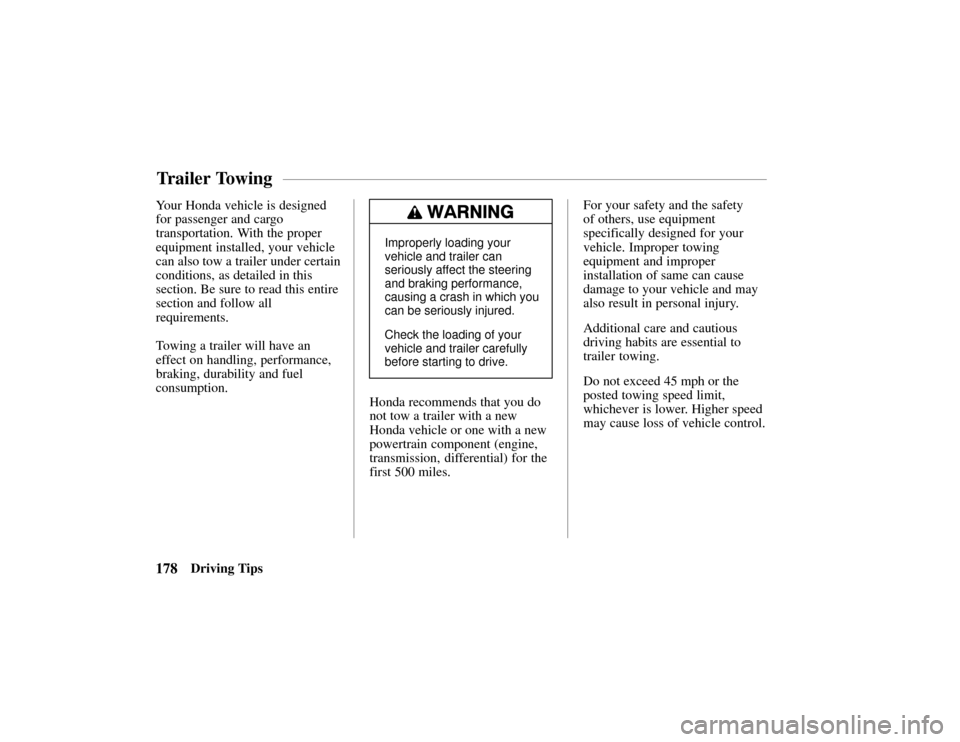
178Driving Tips
Your Honda vehicle is designed
for passenger and cargo
transportation. With the proper
equipment installed, your vehicle
can also tow a trailer under certain
conditions, as detailed in this
section. Be sure to read this entire
section and follow all
requirements.
Towing a trailer will have an
effect on handling, performance,
braking, durability and fuel
consumption.
Improperly loading your
vehicle and trailer can
seriously affect the steering
and braking performance,
causing a crash in which you
can be seriously injured.
Check the loading of your
vehicle and trailer carefully
before starting to drive.
Honda recommends that you do
not tow a trailer with a new
Honda vehicle or one with a new
powertrain component (engine,
transmission, differential) for the
first 500 miles.
For your safety and the safety
of others, use equipment
specifically designed for your
vehicle. Improper towing
equipment and improper
installation of same can cause
damage to your vehicle and may
also result in personal injury.
Additional care and cautious
driving habits are essential to
trailer towing.
Do not exceed 45 mph or the
posted towing speed limit,
whichever is lower. Higher speed
may cause loss of vehicle control.
Trailer Towing
Page 194 of 294
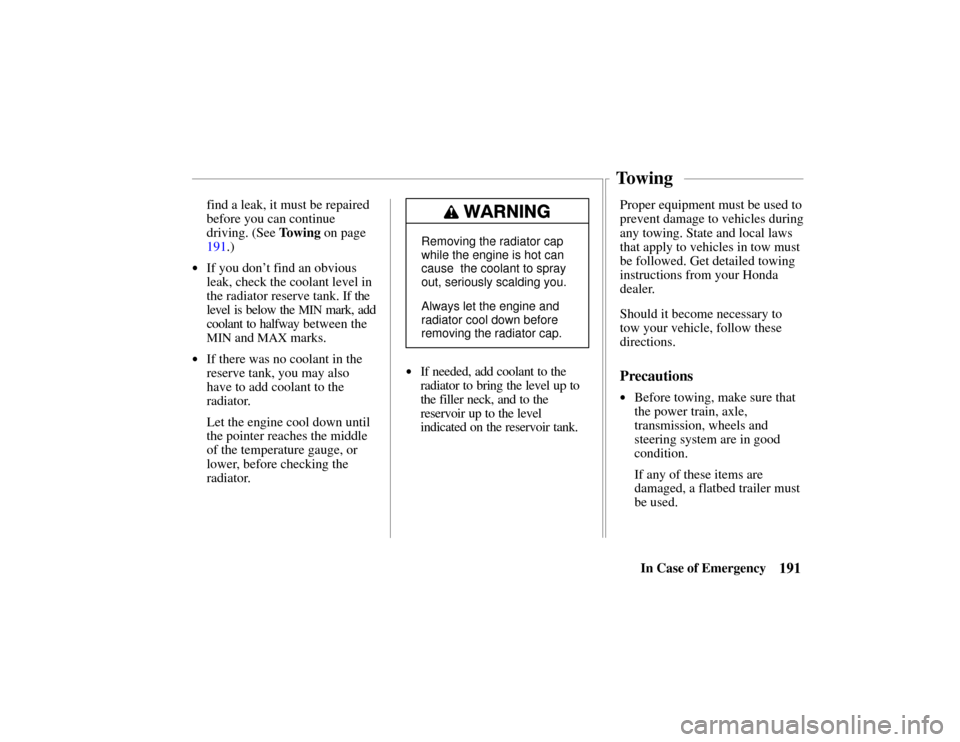
191In Case of Emergency
find a leak, it must be repaired
before you can continue
driving. (See Towing on page
191.)
•If you don’
t find an obvious
leak, check the coolant level in
the radiator reserve tank. If the
level is below the
MIN mark, add
coolant to halfway between the
MIN and MAX marks.
•If there was no coolant in the
reserve tank, you may also
have to add coolant to the
radiator.
Let the engine cool down until
the pointer reaches the middle
of the temperature gauge, or
lower, before checking the
radiator.
Removing the radiator cap
while the engine is hot can
cause the coolant to spray
out, seriously scalding you.
Always let the engine and
radiator cool down before
removing the radiator cap.
•
If needed, add coolant to the
radiator to bring the level up to
the filler neck, and to the
reservoir up to the level
indicated on the reservoir tank. Proper equipment must be used to
prevent damage to vehicles during
any towing. State and local laws
that apply to vehicles in tow must
be followed. Get detailed towing
instructions from your Honda
dealer.
Should it become necessary to
tow your vehicle, follow these
directions.Precautions
•Before towing, make sure that
the power train, axle,
transmission, wheels and
steering system are in good
condition.
If any of these items are
damaged, a flatbed trailer must
be used.
Towing
Page 196 of 294
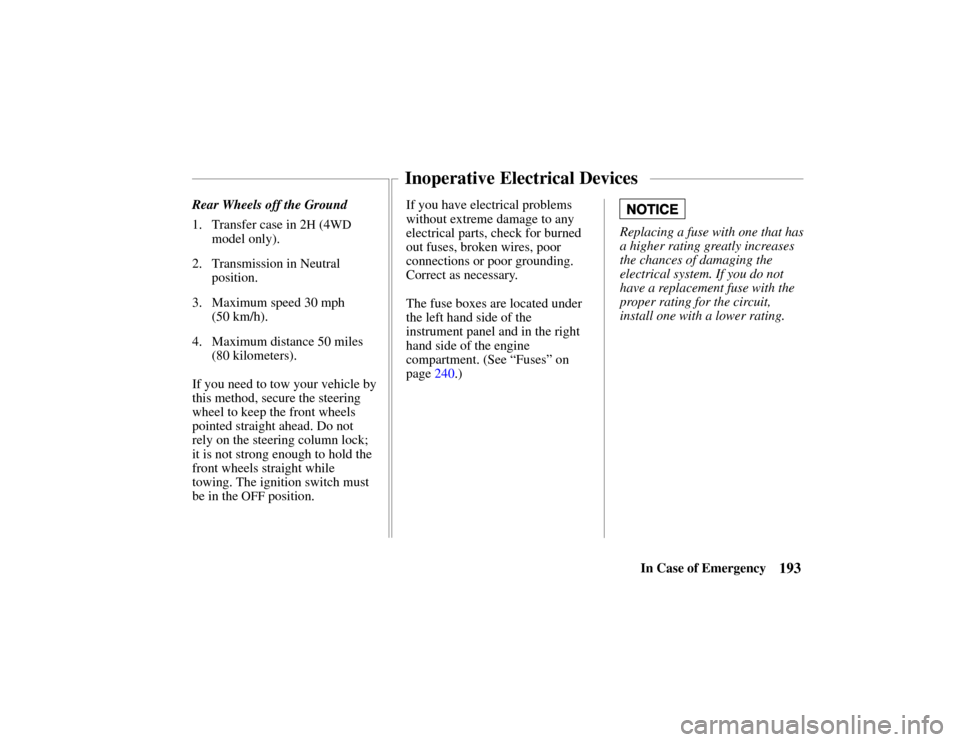
193In Case of Emergency
Rear Wheels off the Ground
1.
Transfer case in 2
H (4WD
model only).
2. Transmission in Neutral
position.
3. Maximum speed 30 mph
(50 km/h).
4. Maximum distance 50 miles
(80 kilometers).
If you need to tow your vehicle by
this method, secure the steering
wheel to keep the front wheels
pointed straight ahead. Do not
rely on the steering column lock;
it is not strong enough to hold the
front wheels straight while
towing. The ignition switch must
be in the
OFF position. If you have electrical problems
without extreme damage to any
electrical parts, check for burned
out fuses, broken wires, poor
connections or poor grounding.
Correct as necessary.
The fuse boxes are located under
the left hand side of the
instrument panel and in the right
hand side of the engine
compartment. (See
“Fuses” on
page 240.)
Replacing a fuse with one that has
a higher rating greatly increases
the chances of damaging the
electrical system. If you do not
have a replacement fuse with the
proper rating for the circuit,
install one with a lower rating.
Inoperative Electrical Devices
Page 198 of 294
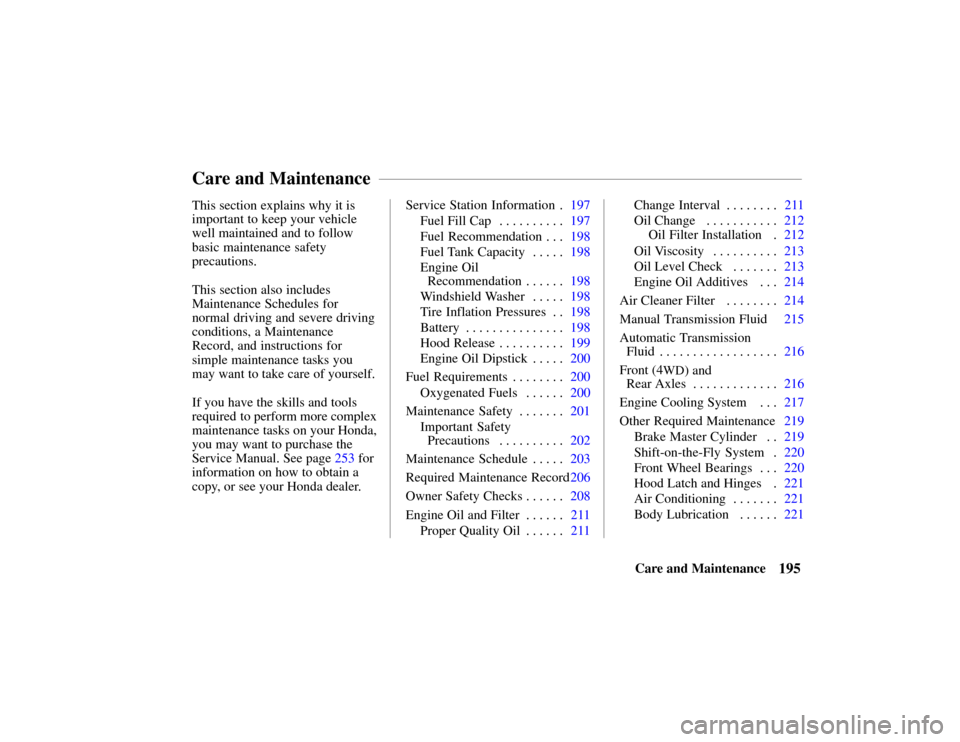
195Care and Maintenance
This section explains why it is
important to keep your vehicle
well maintained and to follow
basic maintenance safety
precautions.
This section also includes
Maintenance Schedules for
normal driving and severe driving
conditions, a Maintenance
Record, and instructions for
simple maintenance tasks you
may want to take care of yourself.
If you have the skills and tools
required
to perform more complex
maintenance tasks on your Honda,
you may want to purchase the
Service Manual. See page 253 for
information on how to obtain a
copy, or see your Honda dealer. Service Station Information
197
.
Fuel Fill Cap 197
. . . . . . . . . .
Fuel Recommendation 198
. . .
Fuel Tank Capacity 198
. . . . .
Engine Oil
Recommendation 198
. . . . . .
Windshield Washer 198
. . . . .
Tire Inflation Pressures 198
. .
Battery 198
. . . . . . . . . . . . . . .
Hood Release 199
. . . . . . . . . .
Engine Oil Dipstick 200
. . . . .
Fuel Requirements 200
. . . . . . . .
Oxygenated Fuels 200
. . . . . .
Maintenance Safety 201
. . . . . . .
Important Safety
Precautions 202
. . . . . . . . . .
Maintenance Schedule 203
. . . . .
Required Maintenance Record 206
Owner Safety Checks 208
. . . . . .
Engine Oil and Filter 211
. . . . . .
Proper Quality Oil 211
. . . . . . Change Interval
211
. . . . . . . .
Oil Change 212
. . . . . . . . . . .
Oil Filter Installation 212
.
Oil Viscosity 213
. . . . . . . . . .
Oil Level Check 213
. . . . . . .
Engine Oil Additives 214
. . .
Air Cleaner Filter 214
. . . . . . . .
Manual Transmission Fluid 215
Automatic Transmission
Fluid 216
. . . . . . . . . . . . . . . . . .
Front (4
WD) and
Rear Axles 216
. . . . . . . . . . . . .
Engine Cooling System 217
. . .
Other Required Maintenance 219
Brake Master Cylinder 219
. .
Shift-on-the-Fly System 220
.
Front Wheel Bearings 220
. . .
Hood Latch and Hinges 221
.
Air Conditioning 221
. . . . . . .
Body Lubrication 221
. . . . . .
Care and Maintenance
Page 201 of 294

198Care and Maintenance
Fuel Recommendation
Use only unleaded gasoline. For
additional information see “Fuel
Requirements” in this section.
Fuel Tank Capacity
19.5 U.S. gallons (75 liters)
Engine Oil Recommendation
Use only SJ quality oil.
The chart shown under “Engine
Oil and Filter” in this section will
serve as a guide for choosing the
proper viscosity oil.
Windshield Washer
Check the reservoir fluid level
regularly. Use a commercially
available windshield washer fluid.
The windshield washer reservoir
is located on the front right side of
the engine compartment.
Tire Inflation Pressures
Check at least monthly, including
the spare. Keep inflated to the
pressure shown on the tire placard
on the driver’s doorjamb.
LABEL
Battery
Your new vehicle has a low
maintenance battery.
CHARGE TEST INDICATOR
UPPER LEVEL
LOWER LEVEL CHARGING
NECESSARY
OK
BLUE COLORLESS
You will never have to add water.
The hydrometer (test indicator) in
the top of the battery provides
information for testing purposes
only.
WARNING : Battery posts,
terminals and related accessories
contain lead and lead compounds.
Wash hands after handling.
Page 203 of 294
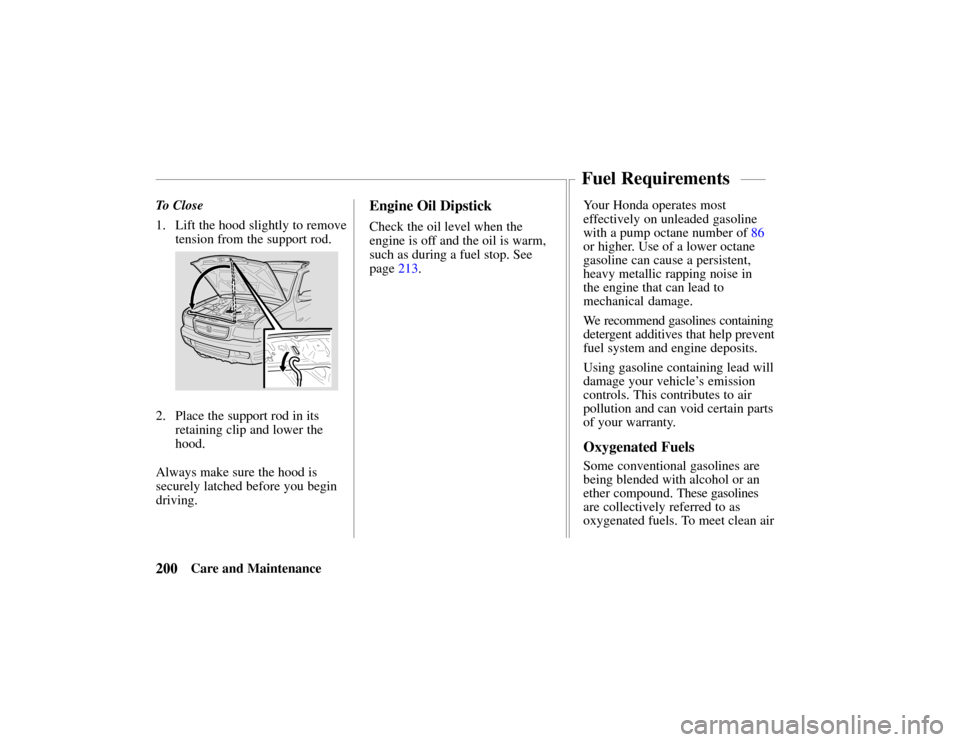
200 Care and Maintenance
To Close
1.
Lift the hood slightly to remove
tension from the support rod.
2. Place the support rod in its
retaining clip and lower the
hood.
Always make sure the hood is
securely latched before you begin
driving.
Engine Oil Dipstick
Check the oil level when the
engine is off and the oil is warm,
such as during a fuel stop. See
page 213. Your Honda operates most
effectively on unleaded gasoline
with a pump octane number of 86
or higher. Use of a lower octane
gasoline can cause a persistent,
heavy metallic rapping noise in
the engine that can lead to
mechanical damage.
We recommend gasolines containing
detergent additives that help prevent
fuel system and engine deposits.
Using gasoline containing lead will
damage your vehicle
’s emission
controls. This contributes to air
pollution and can void certain parts
of your warranty.
Oxygenated Fuels
Some conventional gasolines are
being blended with alcohol or an
ether compound. These gasolines
are collectively referred to as
oxygenated fuels. To meet clean air
Fuel Requirements
Page 205 of 294

202Care and Maintenance
This section includes instructions
for simple maintenance tasks,
such as checking and adding oil.
Any service items not detailed in
this section should be performed
by a Honda technician or other
qualified mechanic.
Some of the most important safety
precautions are given below.
However, we cannot warn you of
every conceivable hazard that can
arise in performing maintenance.
Only you can decide whether or
not you should perform a given
task.
Failure to properly follow
maintenance instructions and
precautions can cause you to
be seriously hurt or killed.
Always follow the procedures
and precautions in this owner
’s
manual.
Important Safety Precautions
Before you begin any
maintenance, make sure your
vehicle is parked on level ground
and that the parking brake is on.
Also, be sure the engine is off.
This will help to eliminate several
potential hazards:
•Carbon monoxide poisoning
from engine exhaust.
Be sure
there is adequate ventilation
whenever you operate the engine.
•Burns from hot parts. Let the
engine and exhaust system cool
before touching any parts.
•Injury from moving parts. Do
not run the engine unless
instructed to do so.
Read the instructions before you
begin, and make sure you have
the tools and skills required.
To reduce the possibility of fire or
explosion, be careful when
working around gasoline or
batteries. Use a commercially
available degreaser or parts
cleaner, not gasoline, to clean
parts. Keep cigarettes, sparks, and
flames away from the battery and
all fuel-related parts.
You should wear eye protection
and protective clothing when
working near the battery or when
using compressed air.
Page 206 of 294
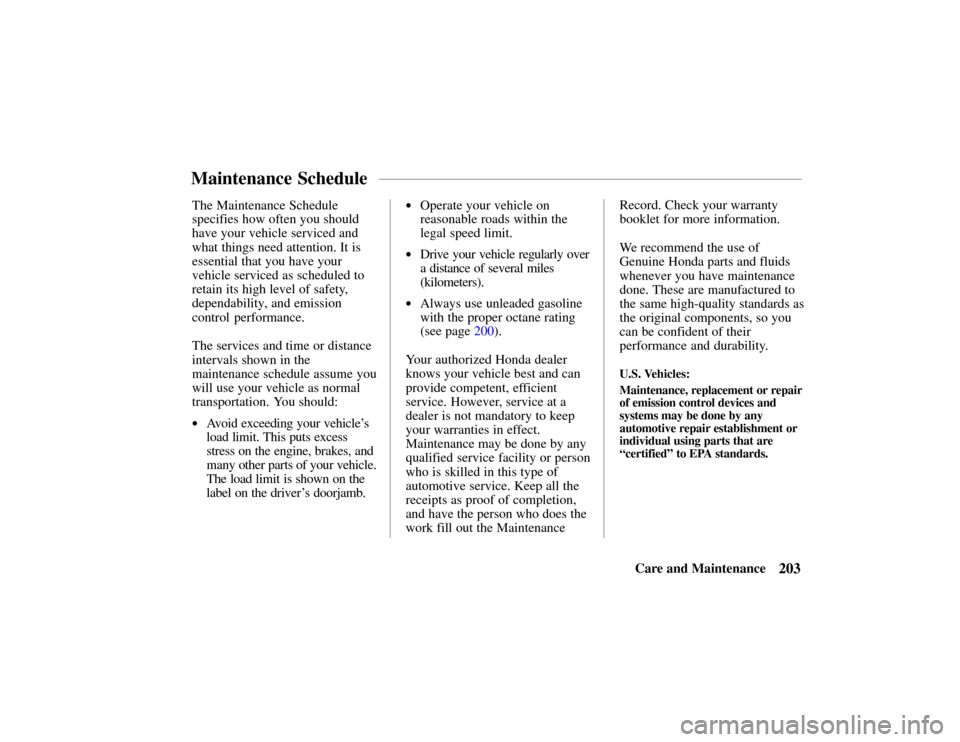
203Care and Maintenance
The Maintenance Schedule
specifies how often you should
have your vehicle serviced and
what things need attention. It is
essential that you have your
vehicle serviced as scheduled to
retain its high level of safety,
dependability, and emission
control performance.
The services and time or distance
intervals shown in the
maintenance schedule assume you
will use your vehicle as normal
transportation. You should:
•
Avoid exceeding your vehicle’s
load limit. This puts excess
stress on the engine, brakes, and
many other parts of your vehicle.
The load limit is shown on the
label on the driver’s doorjamb.
• Operate your vehicle on
reasonable roads within the
legal speed limit.
• Drive your vehicle regularly over
a distance of several miles
(kilometers).
• Always use unleaded gasoline
with the proper octane rating
(see page 200).
Your authorized Honda dealer
knows your vehicle best and can
provide competent, efficient
service. However, service at a
dealer is not mandatory to keep
your warranties in effect.
Maintenance may be done by any
qualified service facility or person
who is skilled in this type of
automotive service. Keep all the
receipts as proof of completion,
and have the person who does the
work fill out the Maintenance Record. Check your warranty
booklet for more information.
We recommend the use of
Genuine Honda parts and fluids
whenever you have maintenance
done. These are manufactured to
the same high-quality standards as
the original components, so you
can be confident of their
performance and durability.
U.S. Vehicles:
Maintenance, replacement or repair
of emission control devices and
systems may be done by any
automotive repair establishment or
individual using parts that are
“certified” to EPA standards.
Maintenance Schedule
Page 207 of 294
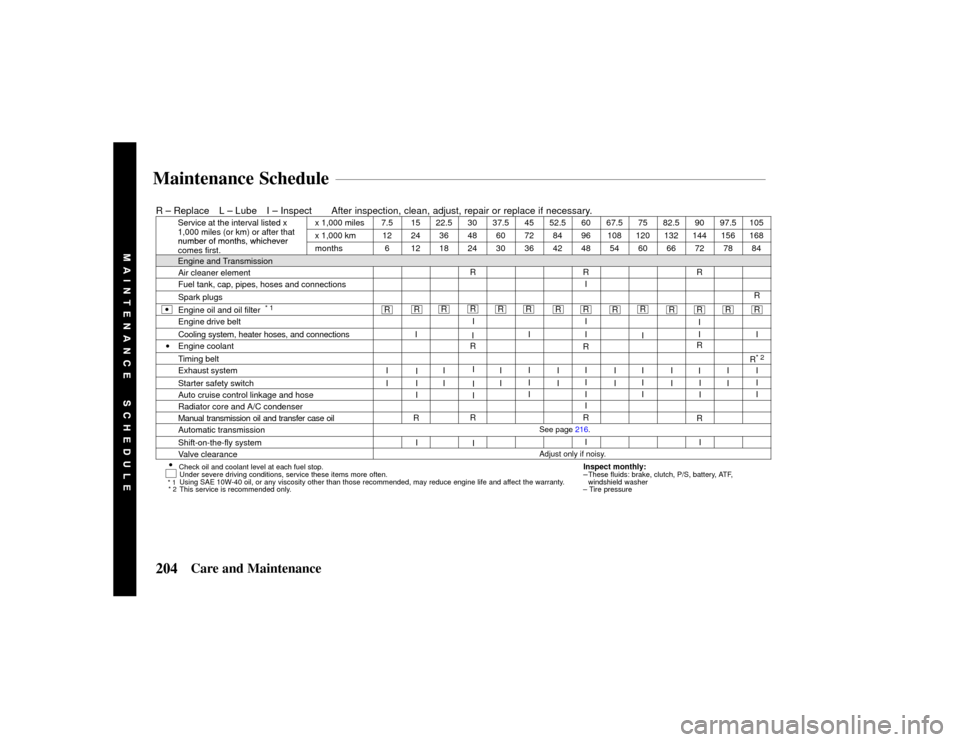
•
* 1
* 2Under severe driving conditions, service these items more often. –These fluids: brake, clutch, P/S, battery, ATF,
Using SAE 10W-40 oil, or any viscosity other than those recommended, may reduce engin\
e life and affect the warranty. windshield washer
This service is recommended only. – Tire pressure
204 Care and Maintenance
R – Replace L – Lube I – Inspect After inspection, clean, adjust, repair or replace if necessary.Service at the interval listed x1 000 il ( k ) ft th tx 1,000 miles7.51522.53037.54552.56067.57582.59097.5105Service at the interval listed x1,000 miles (or km) or after thatnumber of months whicheverx 1,000 km1224364860728496108120132144156168number of months, whichever
comes first.months612182430364248546066727884
Engine and TransmissionAir cleaner elementRRR
Fuel tank, cap, pipes, hoses and connectionsI
Spark plugsR
•Engine oil and oil filter * 1RRRRRRRRRRRRRREngine drive beltIII
Cooling system, heater hoses, and connectionsIIIIIII•Engine coolantRRR
Timing beltR*
2
Exhaust systemIIIIIIIIIIIIII
Starter safety switchIIIIIIIIIIIIII
Auto cruise control linkage and hoseIIIIIII
Radiator core and A/C condenserI
Manual transmission oil and transfer case oilRRRRAutomatic transmissionSee page 216.
Shift-on-the-fly systemIIIIValve clearanceAdjust only if noisy.
Check oil and coolant level at each fuel stop.Inspect monthly:
Maintenance Schedule
Page 208 of 294
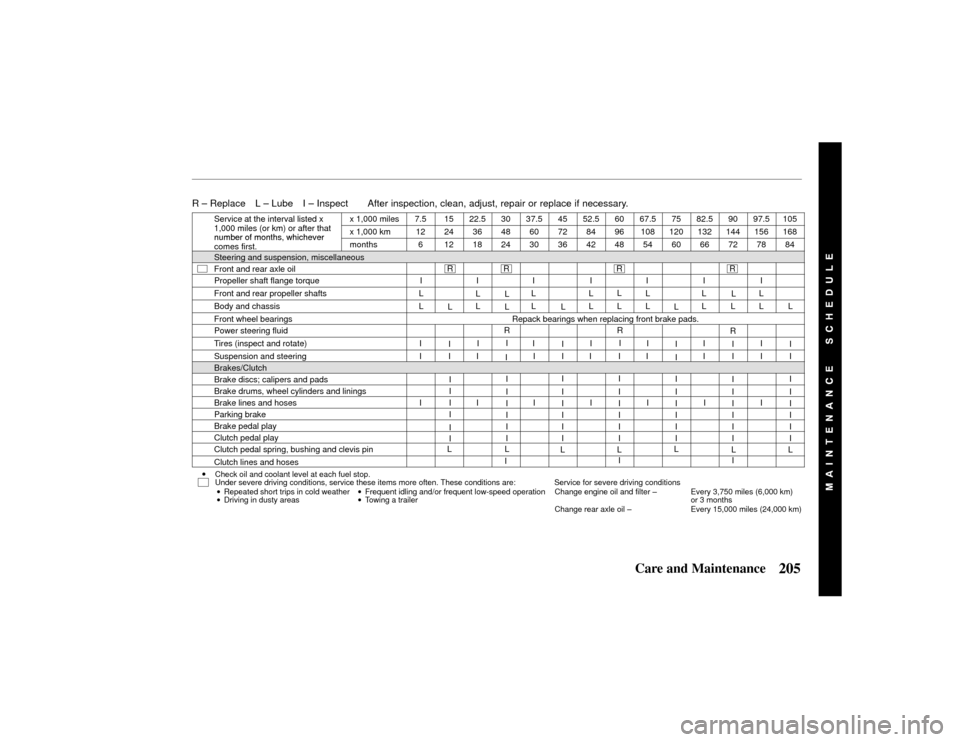
•
•Repeated short trips in cold weather
• Driving in dusty areas •
Frequent idling and/or frequent low-speed operation
• Towing a trailer Change engine oil and filter
–Every 3,750 miles (6,000 km)
or 3 months
Change rear axle oil –Every 15,000 miles (24,000 km)
205Care and Maintenance
R – Replace L – Lube I – Inspect After inspection, clean, adjust, repair or replace if necessary.
Service at the interval listed x1 000 il ( k ) ft th tx 1,000 miles7.51522.53037.54552.56067.57582.59097.5105Service at the interval listed x1,000 miles (or km) or after thatnumber of months whicheverx 1,000 km1224364860728496108120132144156168number of months, whichever
comes first.months612182430364248546066727884
Steering and suspension, miscellaneousFront and rear axle oilRRRRPropeller shaft flange torqueIIIIIII
Front and rear propeller shaftsLLLLLLLLLL
Body and chassisLLLLLLLLLLLLLL
Front wheel bearingsRepack bearings when replacing front brake pads.Power steering fluidRRR
Tires (inspect and rotate)IIIIIIIIIIIIII
Suspension and steeringIIIIIIIIIIIIIIBrakes/ClutchBrake discs; calipers and padsIIIIIII
Brake drums, wheel cylinders and liningsIIIIIIIBrake lines and hosesIIIIIIIIIIIIIIParking brakeIIIIIIIBrake pedal playIIIIIIIClutch pedal playIIIIIIIClutch pedal spring, bushing and clevis pinLLLLLLL
Clutch lines and hosesIII
Check oil and coolant level at each fuel stop.
Under severe driving conditions, service these items more often. These c\
onditions are: Service for severe driving conditions